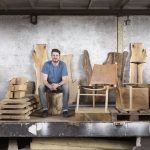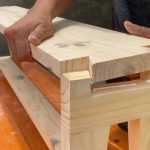Unleash Your Creativity With These Woodworking Projects: Baby Changing Table – Get Inspired And Start Crafting Now!
Woodworking Projects: Building a Functional and Stylish Baby Changing Table
Introduction
As a woodworking enthusiast, I have always been intrigued by the challenge of creating functional and beautiful furniture pieces. One project that particularly caught my interest was building a baby changing table. Not only does it provide a safe and convenient space for diaper changes, but it also adds a touch of style to a nursery. In this article, I will share my experience with woodworking projects focused on creating a baby changing table. From the materials used to the steps involved, I will provide a comprehensive guide for fellow woodworking enthusiasts and parents-to-be.
2 Picture Gallery: Unleash Your Creativity With These Woodworking Projects: Baby Changing Table – Get Inspired And Start Crafting Now!


What is a Baby Changing Table?

Image Source: lazyguydiy.com
A baby changing table is a piece of furniture designed specifically for diaper changes and organizing baby essentials. It typically features a flat surface with raised edges to prevent the baby from rolling off. The table often comes with storage compartments or shelves to hold diapers, wipes, and other necessities within easy reach. While it serves a practical purpose, a well-crafted baby changing table can also enhance the aesthetic appeal of a nursery.
Who Can Benefit from a Woodworking Project?
Woodworking projects are not limited to professionals or experienced craftsmen. In fact, anyone with basic woodworking skills and a passion for creating can embark on building a baby changing table. Whether you are a parent-to-be looking to personalize your nursery or a woodworking enthusiast seeking a challenging project, building a baby changing table can be a rewarding endeavor.
When and Where to Start?

Image Source: pinimg.com
The ideal time to start a woodworking project for a baby changing table is during the early stages of pregnancy or even before. This allows ample time to plan, gather materials, and complete the project before the baby arrives. As for the location, a well-ventilated and well-lit workshop or garage would be an ideal space for woodworking. However, with proper safety precautions, the project can also be completed in a smaller space like a basement or backyard shed.
Why Choose Woodworking Projects for Baby Changing Tables?
There are several advantages to building a baby changing table through woodworking projects. Firstly, it allows you to create a customized piece that perfectly suits your preferences and complements your nursery decor. Additionally, woodworking projects offer a sense of satisfaction and accomplishment, especially when you witness the finished product you have crafted with your own hands. Lastly, building your own baby changing table can save you money compared to purchasing a pre-made one from a store.
How to Start a Woodworking Project for a Baby Changing Table?
Starting a woodworking project for a baby changing table requires careful planning and preparation. Here are the basic steps involved:
1. Design and Measurements:
Begin by sketching out your desired design and taking accurate measurements. Consider the available space in the nursery and the specific features you want to incorporate into the changing table.
2. Gather Materials and Tools:
Select high-quality wood that is sturdy and free from defects. Common choices include hardwoods like oak, maple, or birch. Additionally, gather the necessary tools such as a table saw, miter saw, drill, sandpaper, and safety equipment.
3. Cut and Prepare the Wood:
Using the measurements, cut the wood pieces according to your design. Sand down the rough edges and ensure all surfaces are smooth for a professional finish.
4. Assemble the Changing Table:
Follow your design plan to assemble the different components of the baby changing table. Use wood glue and screws to secure the joints and reinforce stability. Take your time to ensure everything is aligned properly.
5. Apply Finishing Touches:
Once the table is assembled, it’s time to apply the finishing touches. This may include staining or painting the wood to achieve the desired color and protection. Apply multiple coats of finish for durability and a polished look.
Frequently Asked Questions (FAQs)
Q: Is it safe to build my own baby changing table?
A: When constructed properly and with attention to safety measures, a homemade baby changing table can be just as safe as store-bought ones. Ensure the table is sturdy, has raised edges, and is securely anchored to the wall to prevent tipping.
Q: How long does it take to complete a woodworking project for a baby changing table?
A: The time required depends on factors such as your woodworking experience, complexity of the design, and the availability of tools. On average, it can take anywhere from a few days to a few weeks to complete the project.
Q: Can I modify the design of the baby changing table?
A: Absolutely! One of the advantages of woodworking projects is the flexibility to personalize and modify designs according to your preferences. Feel free to add or remove features, adjust dimensions, or incorporate unique elements into your baby changing table.
Types, Sizes, and Materials
Baby changing tables come in various types and sizes to suit different needs and spaces. Some popular options include wall-mounted changing tables, foldable tables for small spaces, and convertible tables that can transform into a storage cabinet as the child grows. As for materials, hardwoods like oak, maple, and cherry are commonly used due to their durability and aesthetic appeal.
Specifications and Requirements
When building a baby changing table, it is crucial to consider the following specifications and requirements:
– Dimensions: Ensure the table is at a comfortable height for diaper changes and has enough surface area for the baby to lie on.
– Weight Capacity: The table should be able to support the weight of the baby and any additional items placed on it.
– Safety Features: Raised edges, safety straps, and secure anchors are important for the baby’s safety.
– Storage Space: Determine the amount of storage needed for diapers, wipes, clothing, and other baby essentials.
Tips and Tricks
Here are some helpful tips and tricks to keep in mind when undertaking a woodworking project for a baby changing table:
– Measure twice, cut once: Double-check measurements before making any cuts to minimize mistakes.
– Sand and smooth: Take the time to sand down all surfaces for a professional finish and to prevent splinters.
– Test stability: Ensure the table is stable and secure before using it for diaper changes.
– Use non-toxic finishes: Opt for non-toxic finishes to ensure the safety of your baby.
– Personalize the design: Add unique touches or engravings to make the changing table truly your own.
Benefits and Disadvantages
Building a baby changing table through a woodworking project offers several benefits:
– Customization: You have full control over the design and can tailor it to your personal style and needs.
– Cost-effective: Building your own changing table can save money compared to purchasing a pre-made one.
– Sentimental value: A handmade changing table holds sentimental value and can become a family heirloom.
– Skill development: Woodworking projects provide an opportunity to enhance and showcase your woodworking skills.
However, there are also a few disadvantages to consider:
– Time-consuming: Woodworking projects can be time-consuming, requiring patience and attention to detail.
– Initial investment: Gathering the necessary materials and tools can require an initial investment.
– Skill level: Beginners may face a learning curve, and mistakes can occur during the building process.
Price, Discounts, and Availability
The price of building a baby changing table through a woodworking project will vary depending on the materials used, tools required, and any additional features incorporated. While store-bought changing tables can range from $100 to $500 or more, a DIY project can be more cost-effective, potentially saving you 30% to 50% of the retail price.
Discounts and promotions on woodworking materials and tools can often be found online or at local hardware stores. Be sure to compare prices and take advantage of any available discounts to further reduce costs.
Conclusion
Embarking on a woodworking project to build a baby changing table can be a rewarding experience for both woodworking enthusiasts and parents-to-be. By carefully planning, selecting high-quality materials, and employing woodworking techniques, you can create a functional and stylish piece of furniture that adds charm to your nursery. While challenges may arise, the sense of accomplishment and pride in crafting a beautiful and practical changing table for your baby will make the journey well worth it.
This post topic: Crafts

